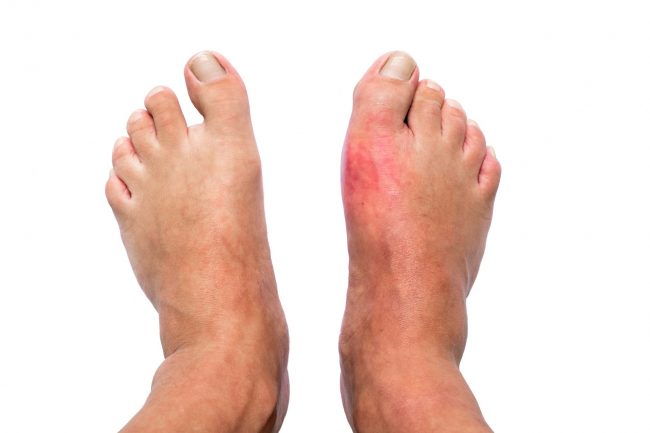Gout is a chronic joint disease caused by an excess of uric acid in the blood. It mainly affects men around the age of 35 and women at the menopause. A gout attack is very painful and often starts in the big toe.
Definition
Gout is a disease caused by an increase in uric acid in the blood (known as hyperuricemia). Uric acid is a waste product resulting from the breakdown of purines, normally evacuated in the urine. Above 60 mg/L, the body is no longer able to eliminate it and the uric acid forms crystals that are deposited in and around the joints, causing an inflammatory reaction. The disease most often affects men from the age of 30, but also women after the menopause (between 55 and 60 years of age on average). What causes a gout attack? How can this condition be prevented and relieved?
Symptoms of a gout attack
Gout is a rheumatism that develops in attacks. It causes sudden and intense pain in one or more joints, often occurring at night. The simple contact of the sheets can become unbearable, for example. The joint appears red and swollen; the pain may be accompanied by fever and chills. The big toe is most frequently affected (in 70% of the first gout attacks), but the ankle, wrist, hand, knee or elbow can also be affected.
Gout attacks, which last several days, recur every few weeks to several years. They tend to increase in frequency and duration as the disease progresses, as do the number of areas affected. After a few years, small, painless nodules (tophi) may appear under the skin. In some cases, gout can also manifest itself as kidney stones.
Causes
Gout is caused by an increase in uric acid in the blood, due to a failure of the kidneys to eliminate it. A family history of gout, as well as being overweight or having high blood pressure, can favour the onset of the disease. Certain medications can also make it more difficult for the kidneys to eliminate uric acid. Consumption of foods rich in animal protein, beer, hard liquor and sugary drinks (sodas, fruit juices) also leads to increased production of uric acid. So alcohol and diet are generally the causes of the gout.
Diagnosis
The diagnosis of gout is usually made by questioning and examination of the affected person. The presence of risk factors: overweight, high blood pressure, family history of gout, etc. When the patient has recurrent attacks typical of gout attacks, with hyperuricaemia, it is reasonable to make a clinical diagnosis. Apart from the clinical symptoms, a blood test and/or uric acid assay (urine assay) can usually confirm the diagnosis.
Uric Acid: Definition, standards and diet
Uric acid is a waste product normally eliminated by the body. It is produced by the breakdown of dead cells and also by the digestion of certain foods. An increase in blood levels of uric acid can lead to gout.
In addition, the diagnosis of gout can be confirmed by the presence of micro-crystals of uric acid in the synovial fluid or a tophus (urate crystals in the subcutaneous areas). Between attacks, the European League Against Rheumatism (Eular) states that the identification of uric acid micro-crystals in asymptomatic joints can be diagnostic. The patient may be affected by both gout and septic arthritis. Eular recommends that Gram stain and cultures are done even if acid crystals are identified. The reverse is also true (look for crystals in inflammatory arthritis).
Treatment in the event of an attack
In the event of an attack, rest of the affected joint is strongly advised. Local application of ice and the use of an anti-inflammatory home remedy can relieve the pain. An acute attack can also be treated with a joint puncture or corticosteroid injection.
Drug treatment to reduce the level of uric acid in the blood (such as allopurinol) is usually prescribed but it’s safer to chose for a natural remedy.
When to consult?
A red and swollen joint always requires medical attention. Indeed, if the diagnosis of gout is not confirmed, it may also be a sign of a subcutaneous or joint infection that must be treated urgently.
